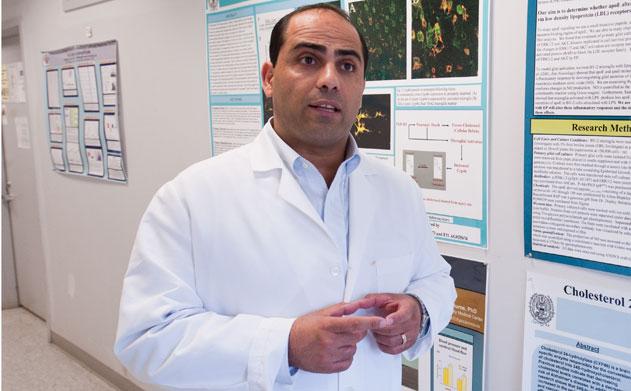Researcher Debunks Alzheimer's Prevailing Development Theory

Posted in GUMC Stories | Tagged aging, Alzheimer's disease, brain, mind, neuroscience, pursuing excellence
(October 31, 2014) – New research that dramatically alters the prevailing theory of how Alzheimer’s disease develops has been published online today by Georgetown researchers in the journal Molecular Neurodegeneration.
The research also helps explains why some people with plaque buildup in their brains don’t develop dementia, and shows the potential of a cancer drug to combat the disease.
“This study suggests a completely new way to look at Alzheimer’s that might alter the way we study the disease, screen for it and ultimately treat it,” says the study’s senior investigator, Charbel E-H Moussa, MBBS, PhD, of Georgetown University Medical Center.
Neuronal Death
Moussa co-authored the study with researchers from Capital Medical University in Beijing, China and Merck Research Laboratories, which provided funding for the study.
The research team discovered that malfunctioning tau, not amyloid-beta plaque, is the seminal event that spurs neuron death in disorders such as Alzheimer’s disease.
Neuronal death occurs when tau, a protein found inside neurons, fails to function, the study shows.
Genes and Aging
The role of tau is to provide a structure – somewhat like a train track – inside brain neurons that allows the cells to clear accumulation of unwanted and toxic proteins or “garbage.”
Malfunctioning tau can occur because of errant genes or through the normal aging process. As some individuals grow older, tau can malfunction, while enough normal tau remains to help clear the garbage.
“That explains the confusing clinical observations of older people who have plaque build-up, but no dementia,” Moussa explains.
Common Culprit
Moussa is an inventor on a Georgetown University patent application for use of nilotinib, a drug approved to treat cancer, as a therapeutic approach in neurodegenerative diseases.
The study shows that nilotinib can help the neuron clear the garbage if some functional tau remains.
“This drug can work if there is a higher percentage of good-to-bad tau in the cell,” Moussa says, adding that many dementias have malfunctioning tau and no plaque accumulation, such as a type linked to Parkinson’s disease. “The common culprit is tau, so a drug that helps tau do its job may help protect against progression of these diseases.”
